Some of the most distinct beetles in the world are white. They come in different shades of white or in different color combinations where white is dominant.
Some of these beetles are also found in North America.
They live around different plant hosts, especially around trees and vegetables.
White beetles largely feed on plant leaves. They can also be predatory while a small number of these bugs can also be scavengers.
White beetles are abundant East of The Rocky Mountains and in many Southern territories across Texas and Florida and further South across Central America.
The following species are seen across the North American continent. Most of them are highly active at the beginning of the summer.
Table of Contents
1. Sri Lanka Weevil
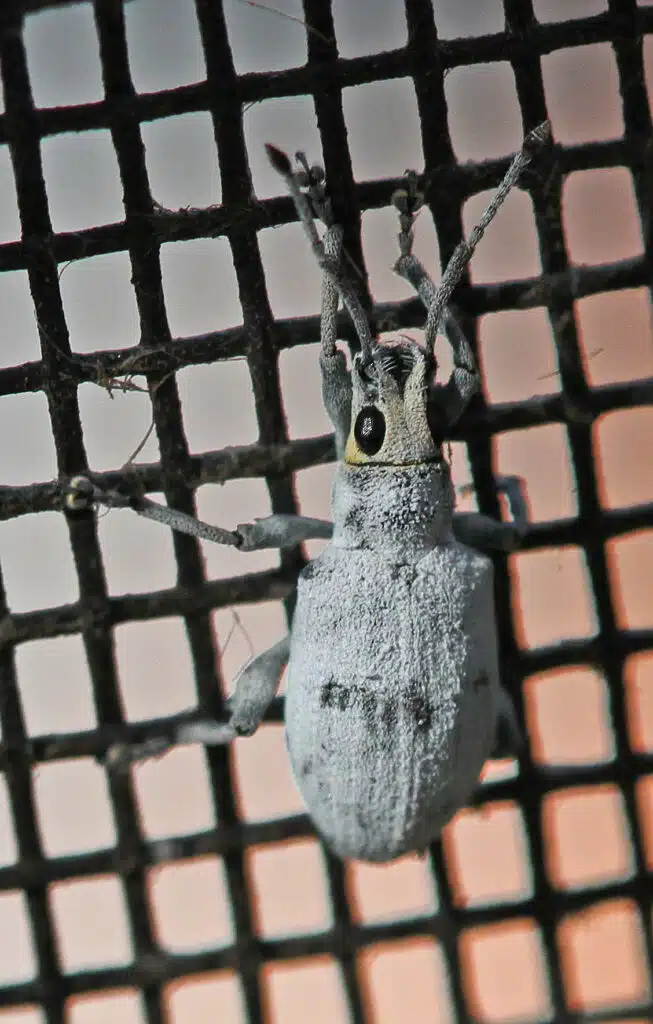
These beetles (Myllocerus undecimpustulatus) are native to an Asian habitat between Sri Lanka and India.
These beetles have now been discovered in North America, especially across Florida.
Central and Southern parts of Florida have the highest numbers of Sri Lanka Weevils.
Growing to a size of up to 8.5mm, this species is almost completely white and a known pest.
It was initially believed the species only eat citrus leaves but it has expanded to hundreds of host species.
Vegetables and ornamental plants are among its long list of hosts.
Over 100 host plants are recorded for these common oriental weevils.
Pesticides are used against the Sri Lanka Weevil which may cause significant damage to crops.
It can eat both the leaves and the roots of its host plant.
2. Inflated Beetle
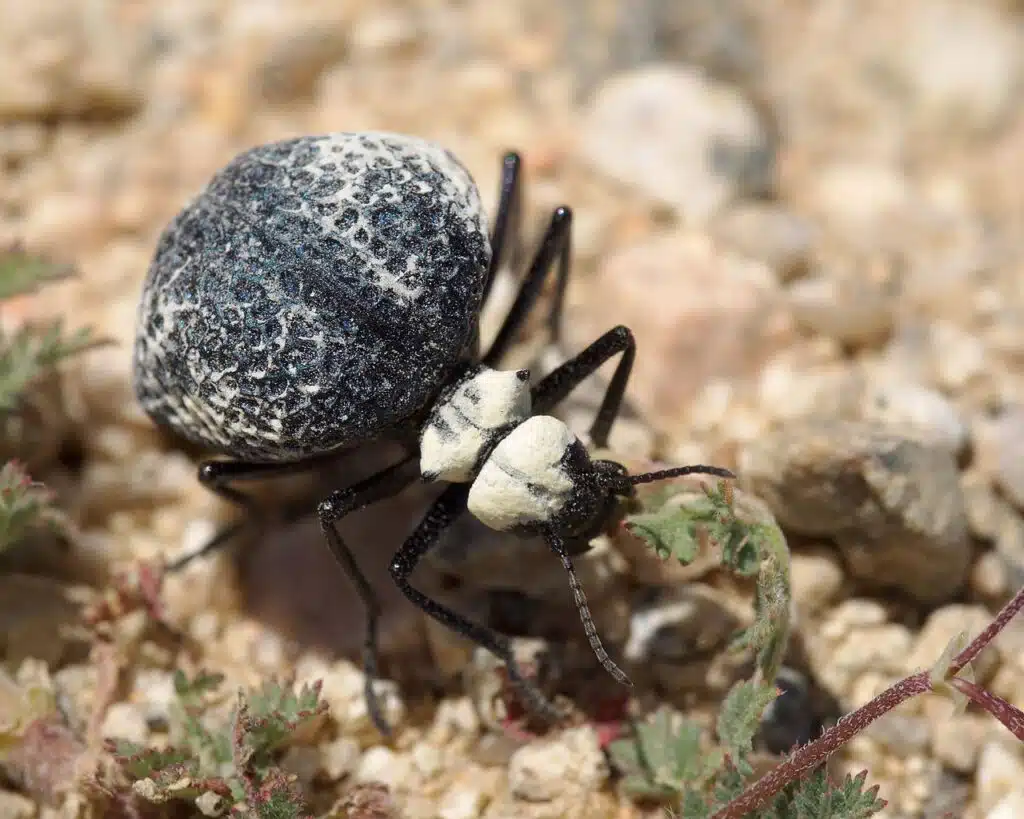
Inflated Beetles (Cysteodemus armatus) get their names to form their balloon-like bodies and long legs.
This is a North American native species with a presence across The Mojave Desert.
Multiple morphs of the species exist, including a white color with black spots.
This species also comes in a yellow morph, a green morph, and even a purple morph.
Beetles of this genus seek out underground bee nests to lay eggs for their larvae to grow in.
Active from early February, Inflated Beetles use greasewood as host plants.
This is a type of medicinal plant with a long history in North America. Native Americans used this plant for treating transmittable diseases.
3. Eastern Beach Tiger Beetle
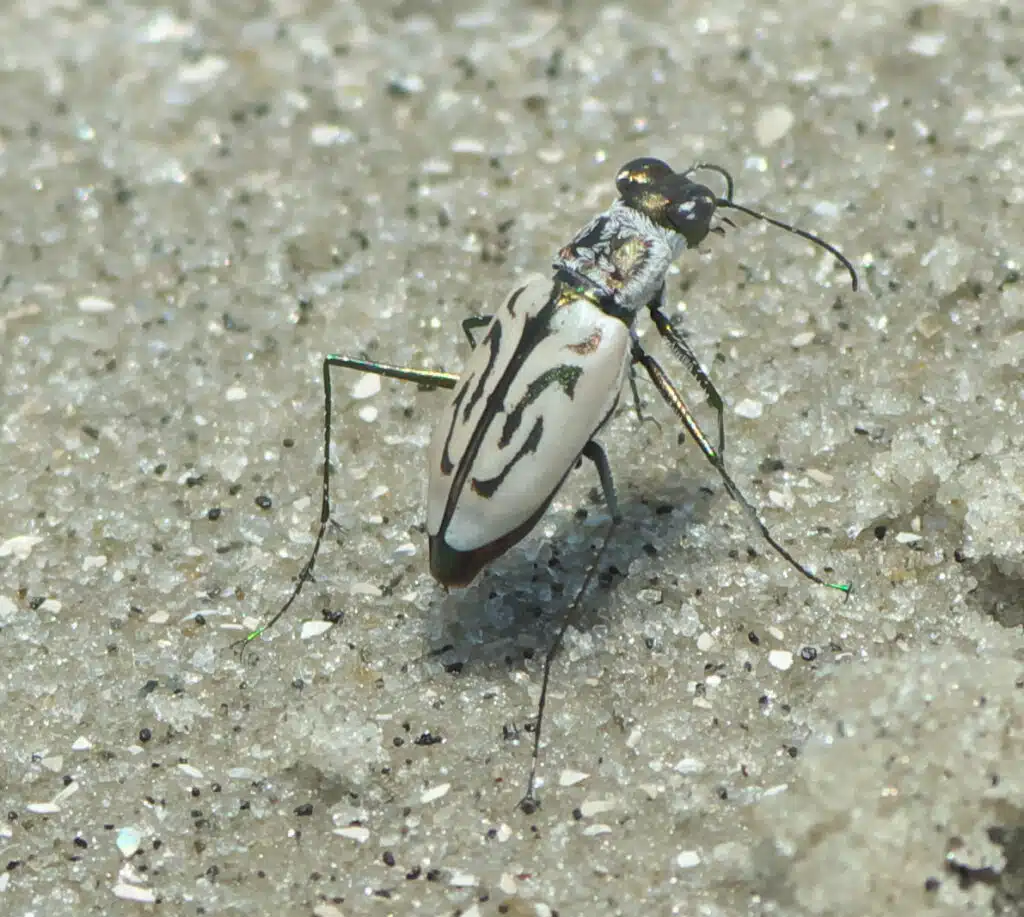
This type of white beetle (Habroscelimorpha dorsalis) is a species native to Northeastern US habitats.
It lives on beaches around coastal areas and it reaches a size of up to 15mm as an adult.
Beetles of this genus are known to be endangered through urbanization which diminishes their natural habitat, beaches.
Larvae of these beetles are laid in the ground. They use a thread-like silk line to lower themselves into the ground.
The larvae of the species are known to feed on insects that get in their range.
Adults of the species are opportunistic eaters, similar to some cockroaches.
They eat insects but they can also eat dead fish brought on the beach by the water.
4. Fifteen-spotted Lady Beetle
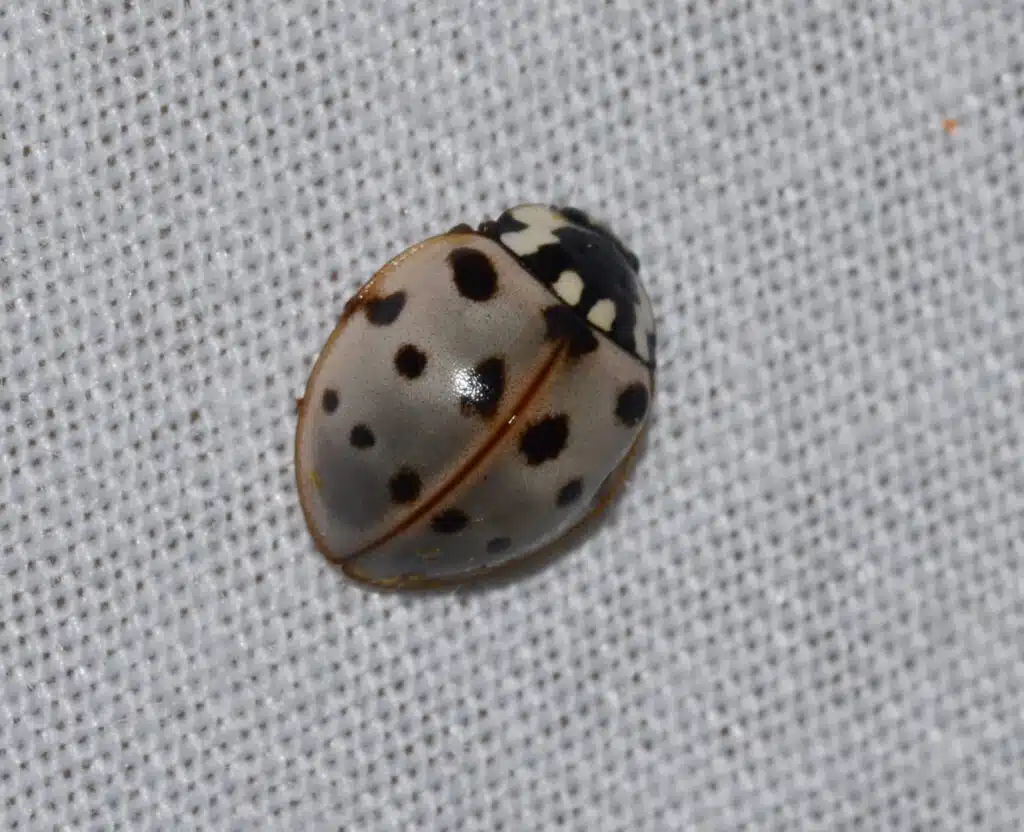
White at first, Fifteen-spotted Lady Beetles (Anatis labiculata) only darken with age. These beetles have white elytra with black spots.
Elytra colors to brown-black as the bug ages.
Its white color starts to become off-white, gray, dark gray, and eventually brown.
This type of beetle is native to North America. It has an extended range across woodlands in Eastern parts of the US.
It’s here that the species feeds on arboreal aphids and mites.
The beetle is also seen in open woodland areas and on beaches
Coniferous woodlands and hardwood tree woodlands are the main habitat of the species which is even present at high altitudes.
5. Epicauta albida
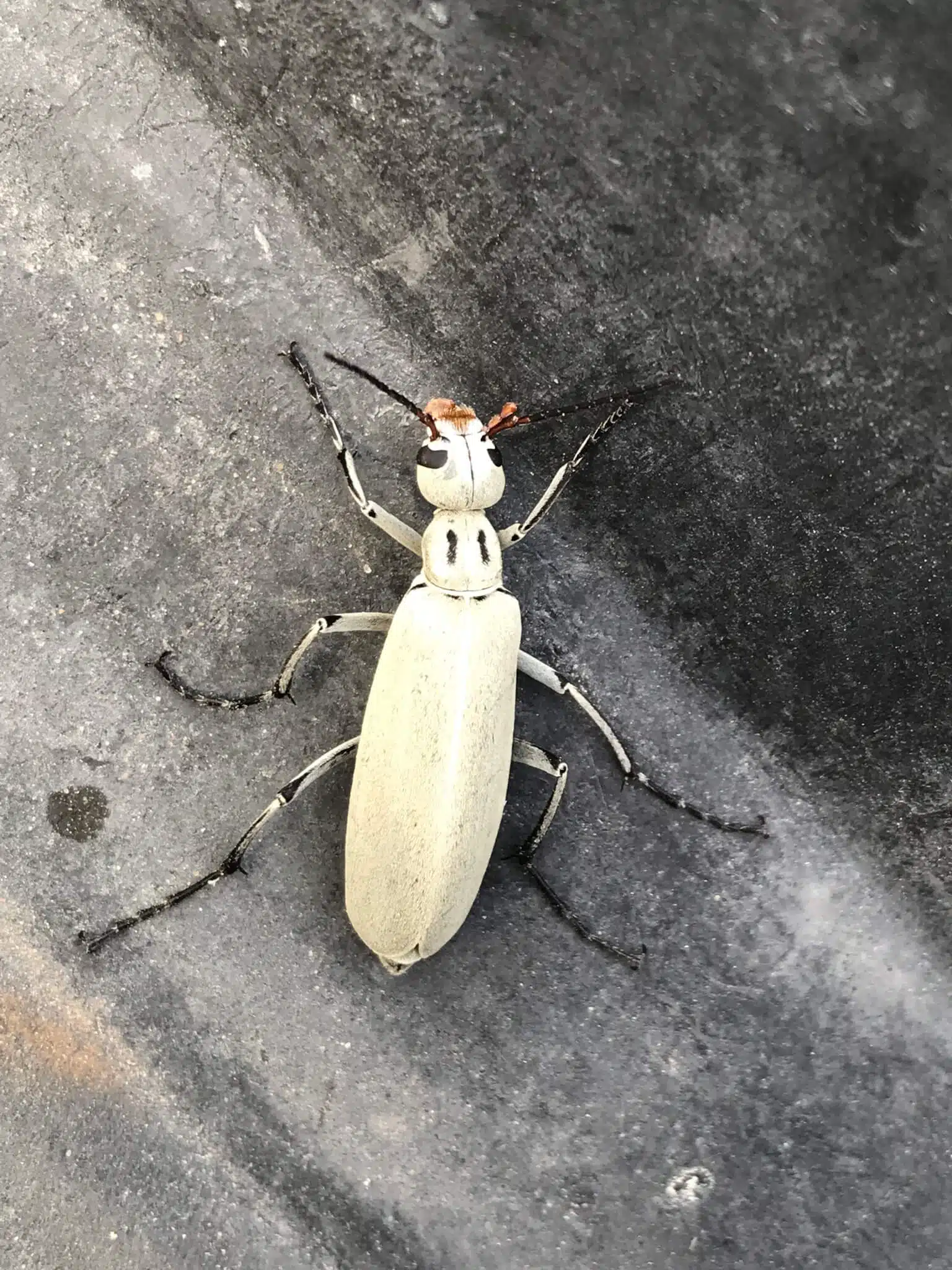
This species of beetles are native to North America.
It has a Southern US range that covers most of Texas.
The species has multiple colors, including a common white morph.
Its head, thorax, and wings are white. The legs of the species are black. Further black marks are also seen across its body.
The underside of the beetle is also white. Unlike its all-white dorsal side, the ventral white side shows contrasting white stripes.
Also seen in a few other colors, this beetle is a common sight in a pale olive-green color.
6. Epicauta nigritarsis
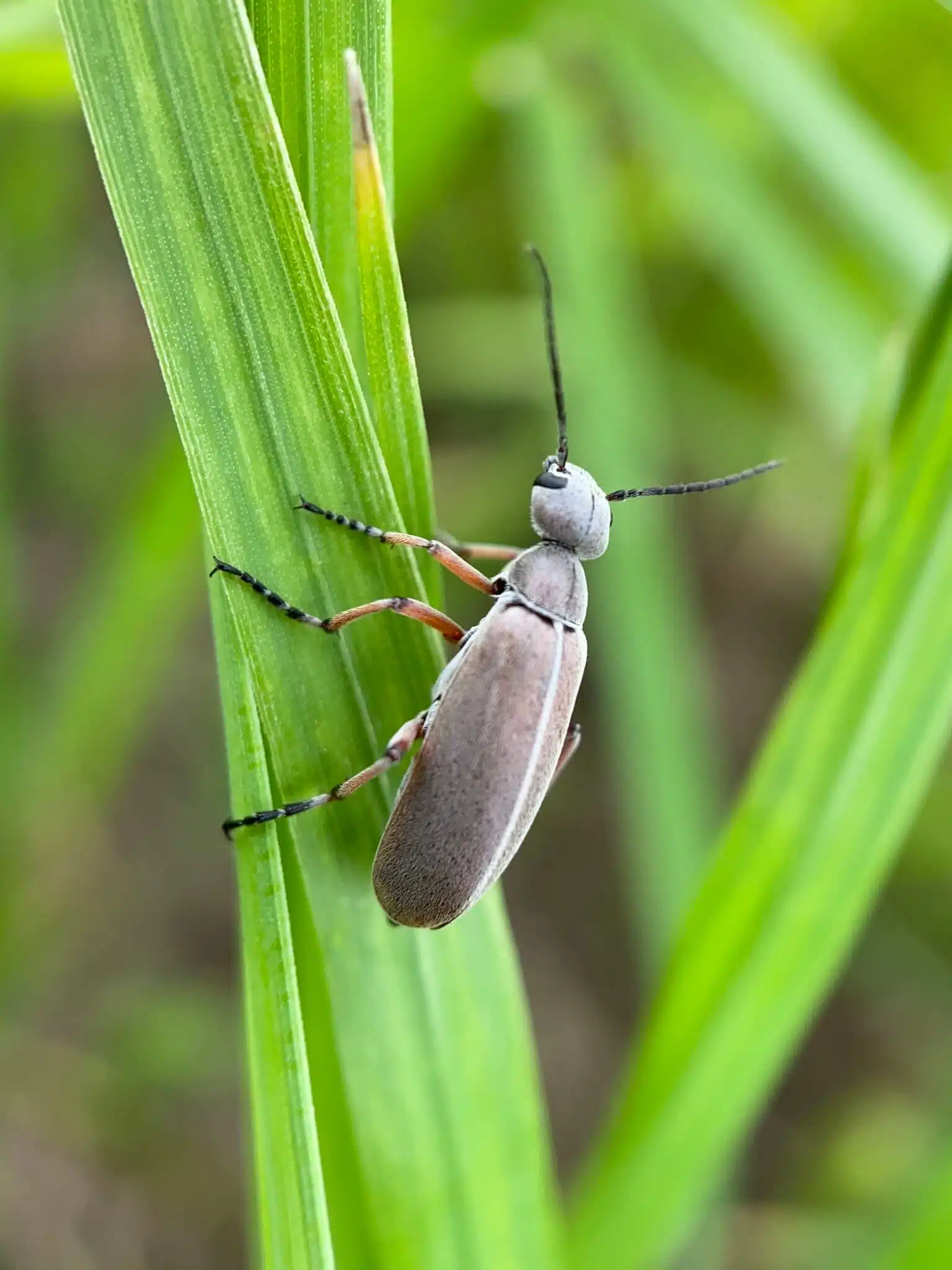
This species of beetle has a Southern US habitat.
Its range expands from Oklahoma to Texas and Arizona.
An off-white color is specific to this species. This color darkens to light gray as the bug grows.
Seen in various sizes, the beetle has a 12mm average length. Its legs typically have a contrasting orange color.
Some of the early signs of the species are seen at the beginning of March. This species has an extended season, being active until October.
Beetles of this genus feed on various plants. They prefer a few different types of mesquite plants for their long roots.
7. Moustached Tiger Beetle
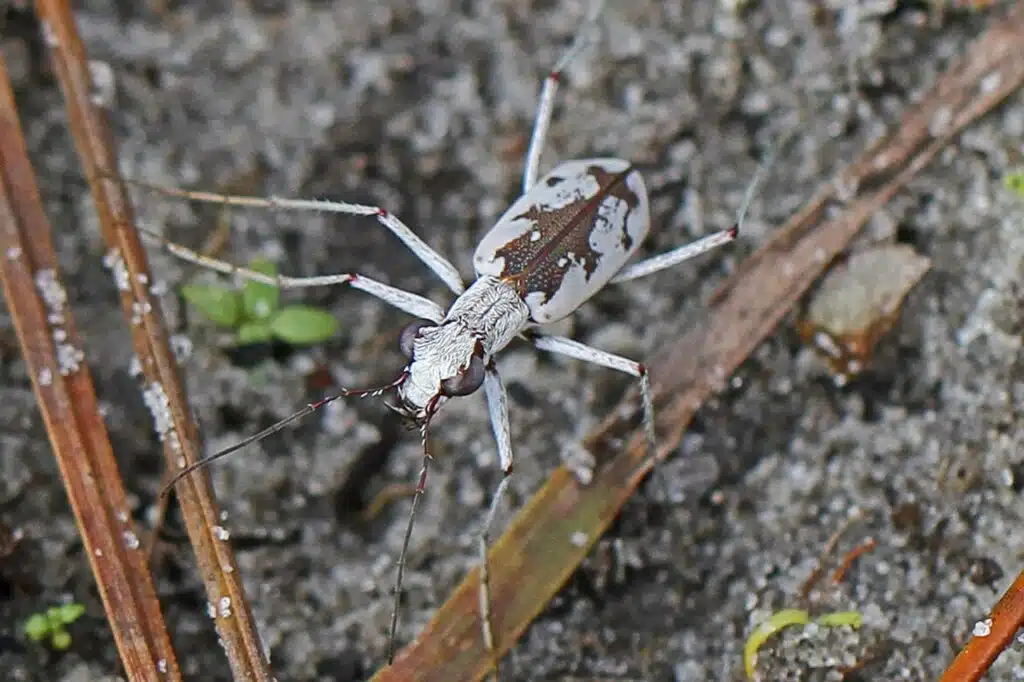
This beetle species (Ellipsoptera hirtilabris) grows to a maximum size of 11mm.
It has extensive white coloring with a single mid-dorsal brown band.
A copper-like nuance is specific to the dark sections of this white beetle.
Moustached Tiger Beetles are endemic to Central Florida.
They are often found around lakes and water sources, particularly on beaches.
White coloring helps this species easily blend in with the environment.
Moustached Tiger Beetles are an active species feeding on insects and arthropods.
This species is not easy to spot as it prefers to hide in plain sight when seeing humans or animals as it blends in with its sandy habitat.
8. Golden-headed Weevil
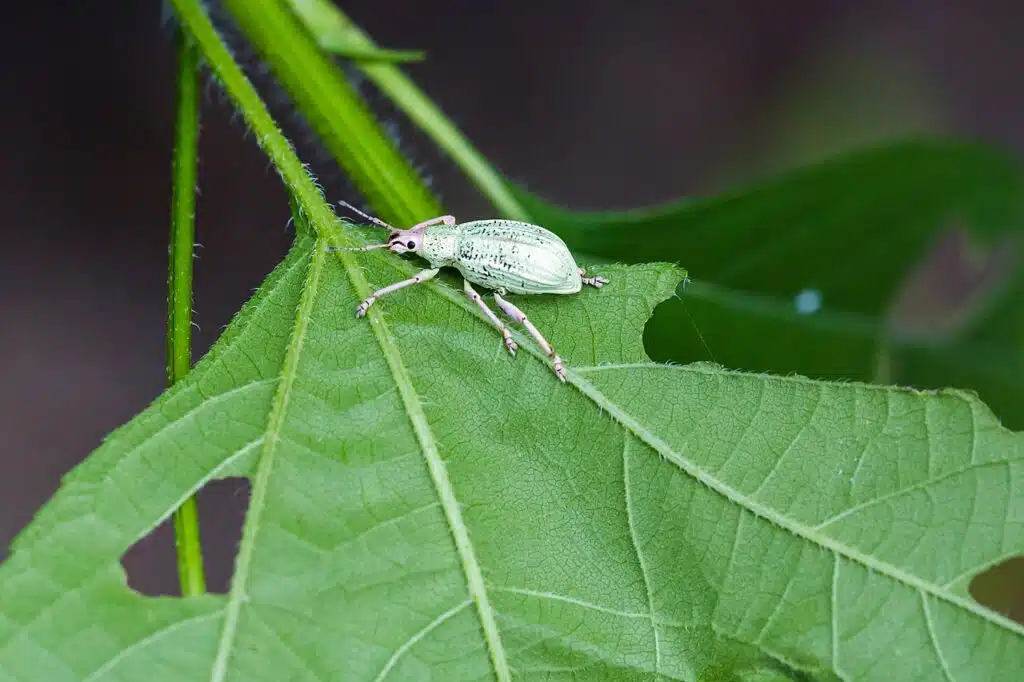
This type of weevil (Compsus auricephalus) is specific to Southern parts of North America and Central America.
Golden-headed Weevils come in a light green color, a dark brown color, or a white color.
Both morphs are associated with a light yellow or dark yellow head, which inspires the name of the species.
It’s not clear which the main host plants of the Golden-headed Weevils are.
Most researchers agree the species seen tens of plants as possible hosts, including palmetto.
These weevils have also been shown to visit host plants they aren’t interested in eating.
There are over 100 Golden-headed Weevil sub-species, all with similar traits.
9. Dogwood Leaf Beetle
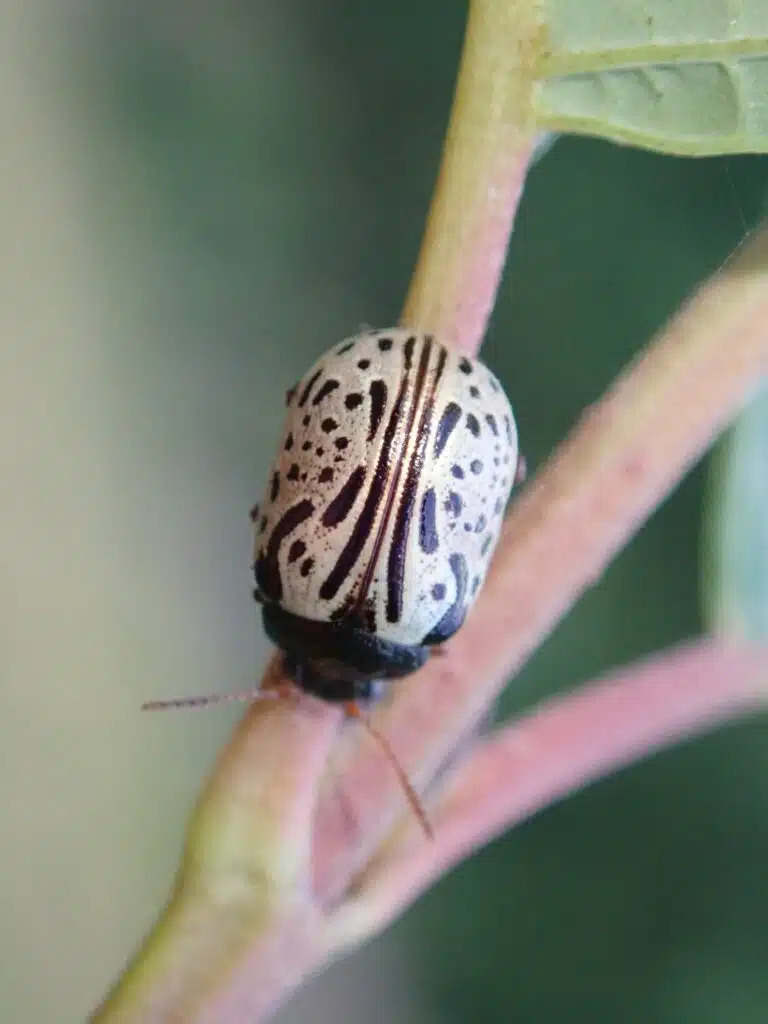
Dogwood Leaf Beetles (Calligrapha philadelphica) are among the most common white beetles in North America.
It grows to a size of at least 8mm and it’s known for its contrasting white and black coloring.
Most of its elytra are white, with black stripes arranged in different directions.
Its cephalothorax is black, with white marks.
This species has a large distribution across multiple US states, given dogwood is also present across much of North America.
Feeding on dogwood leaves, this species takes up to 3 months to become an adult from a simple egg.
Most weevils of this genus never live far away from dogwood, regardless of their life stage.
10. Little Leaf Notcher
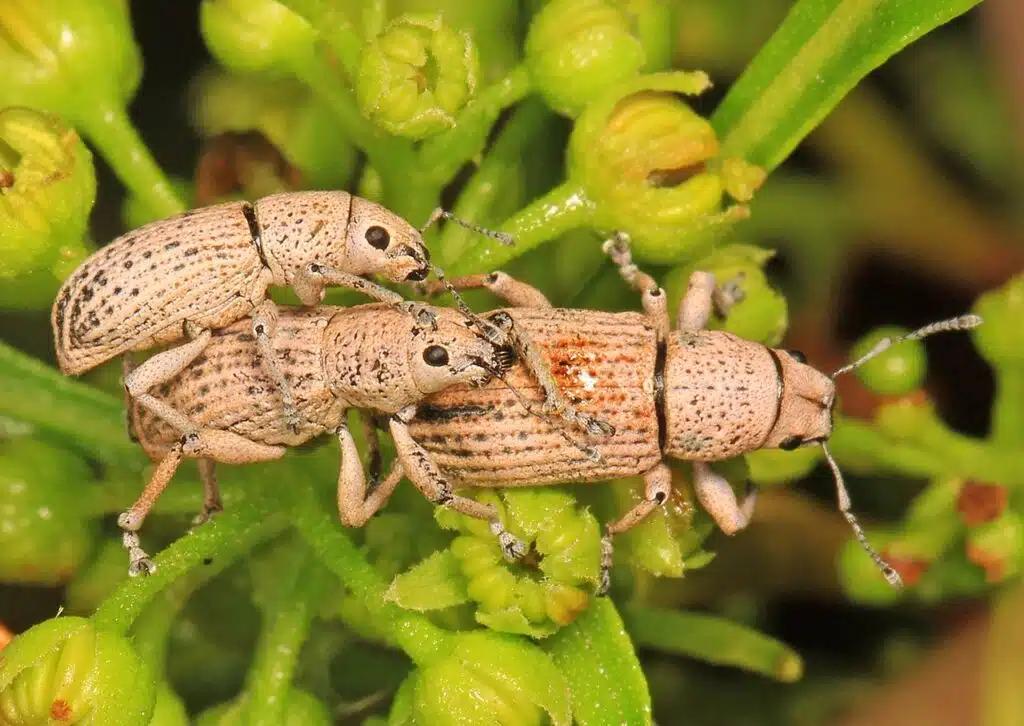
Little Leaf Notches (Artipus floridanus) are named after their habits of eating host plant leaves.
This is a species of mostly white weevils with tiny black spots across the body.
Weevils of this genus are native to Florida. It’s here that they are mostly known as citrus-eating bugs.
They can be seen on oranges, grapefruit, and lemons, feeding on the leaves of these citruses.
To a lesser extent, these weevils might also be spotted on hosts such as mango or lantana, also feeding on leaves.
Economic damages caused by the species are extensive.
Adult Little Leaf Notchers feed on leaves while larvae live underground and feed on roots.
Small feeding differences are spotted between the sexes. Female Little Leaf Notcher weevils eat more than males.
11. Ghost Tiger Beetle
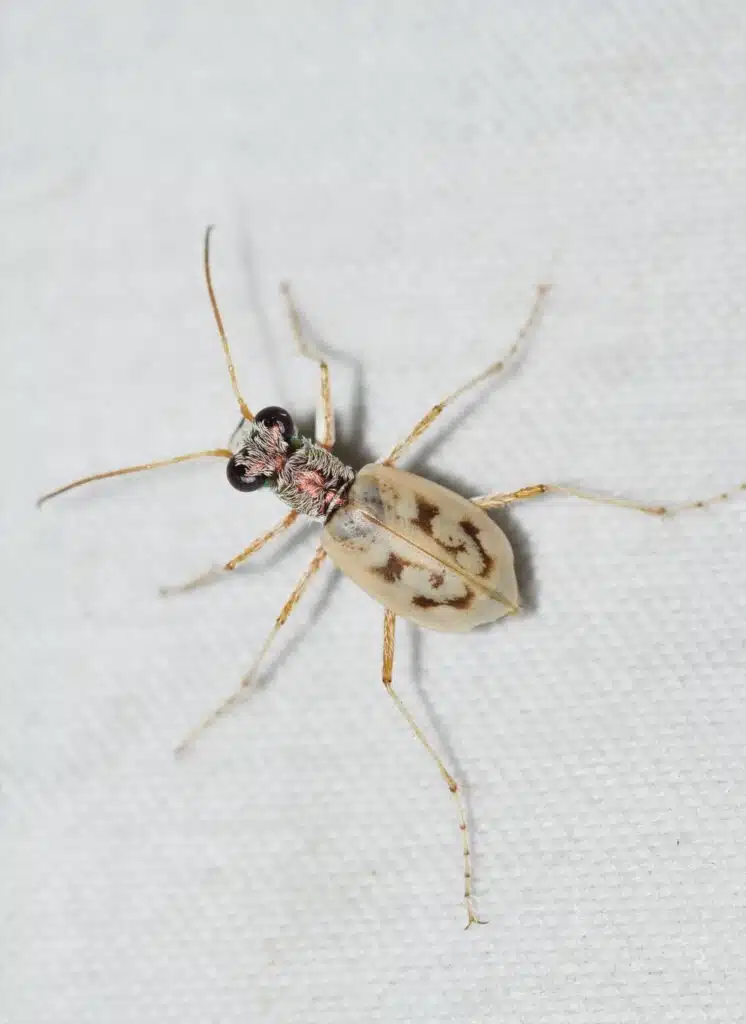
This species (Ellipsoptera lepida) is named after its white-cream body color.
It lives on sandy beaches and it has a light color, similar to other weevils on these types of terrains.
You can find Ghost Tiger Beetles across North American shorelines and around lakes.
This is a mostly white species with brown coloring. It turns slightly cream-gray as it grows.
Size-wise, the species is comparable to other North American white weevils, as it grows to 11mm.
This is a type of ambush predator weevil. Ghost Tiger Beetles dig small burrows in the sand and wait for insects or bugs to come around to quickly catch these insects and drag them inside.
12. Dectes texanus
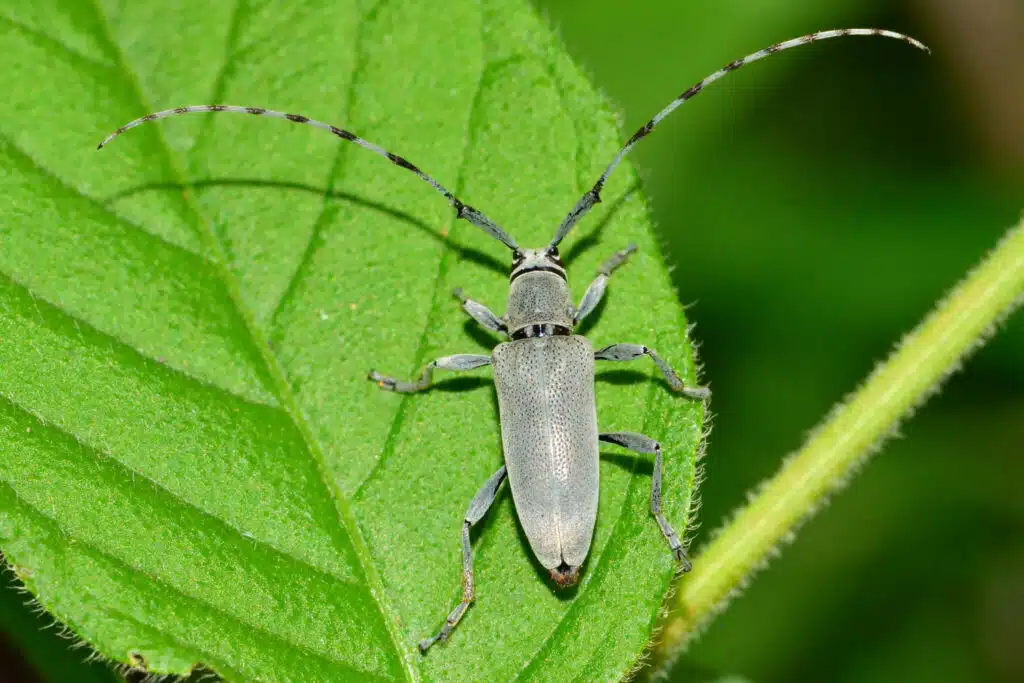
As one of the bugs with long antennae of North America, this species looks disproportionate with its smaller white body.
Dectes texanus is a Southern pest weevil, commonly seen on crops.
It impacts crops to a serious extent. Pesticides are used to control the species.
This weevil is mostly spotted on soybean or sunflower crops.
Its damages aren’t visible at first as the female lays eggs directly in the stems of these hosts, where they hatch and begin eating the host.
Weevils of this family are known for their impact on farming and crop rotation is sometimes used as a preventive measure alongside more specific actions such as spraying pesticides.
13. Ashgray Blister Beetle
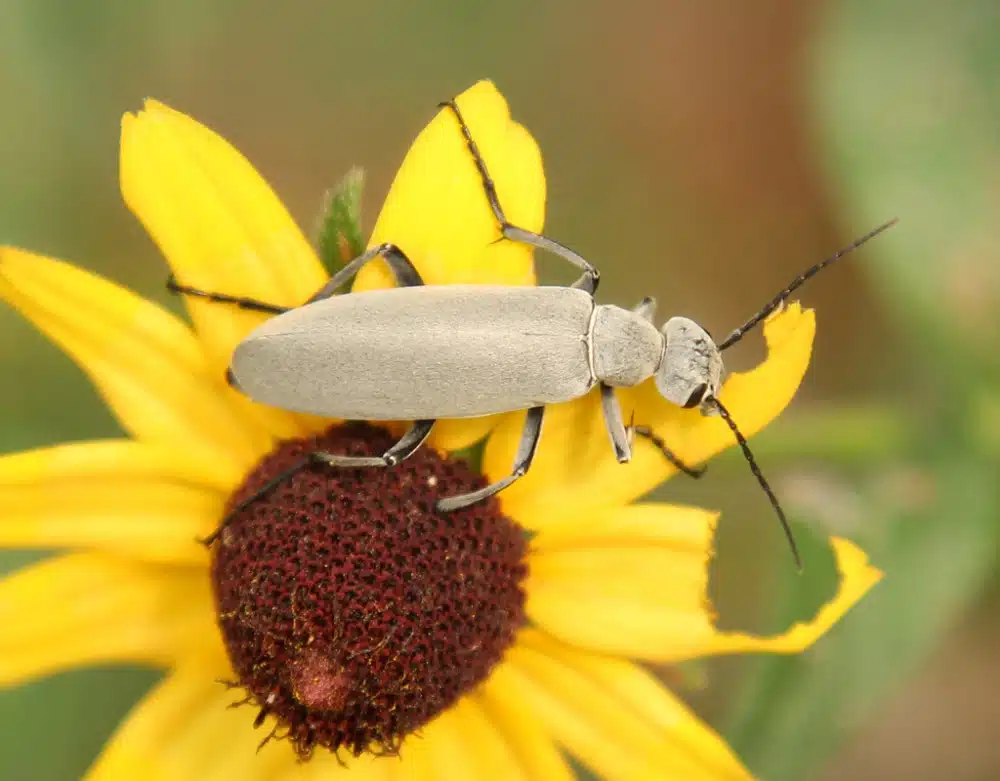
This type of blister beetle (Epicauta fabricii) has a light-gray to white color without any dorsal black marks.
A similar bright color with black bands is specific to the ventral side of the beetle.
Ashgray Blister Beetles are seen on trees, plants, and legumes. They have a pest status across multiple states.
Larvae are fed grasshoppers and other insects bug adults feed on the leaves of trees such as honeylocust.
They also feed on alfalfa and other types of crops.
The specific action is rarely taken against these bugs as Ashgray Beetles are only active for a few weeks.
Pesticides might be considered in case of serious invasions.
14. Common Willow Calligrapher Beetle
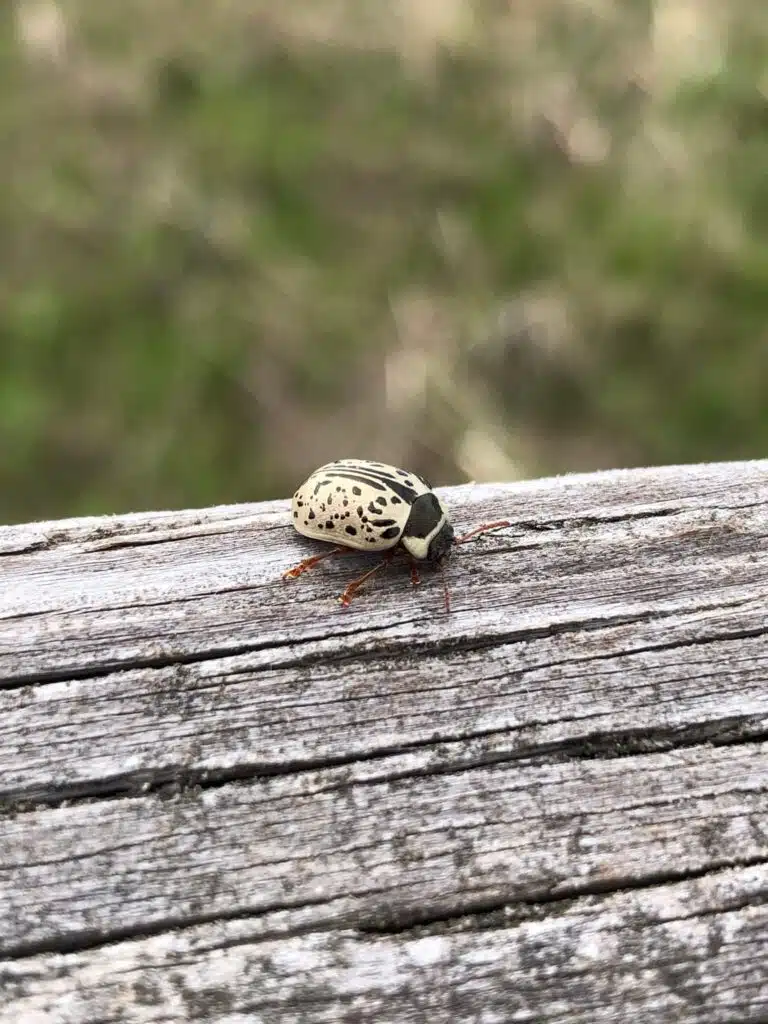
This species (Calligrapha multipunctata) is named after its common willow host.
It can be found around lakes, rivers, streams, and other humid areas willows like to live in.
The Common Willow Calligrapher Beetle is a mostly white species. It has a black cephalothorax with white marks.
As with other white beetles, this is a species with orange-brown legs.
Its size is typically just larger than 6mm.
The end of May and the beginning of June is the period when the Common Willow Calligrapher Beetle is most common.
15. Trichobaris compacta
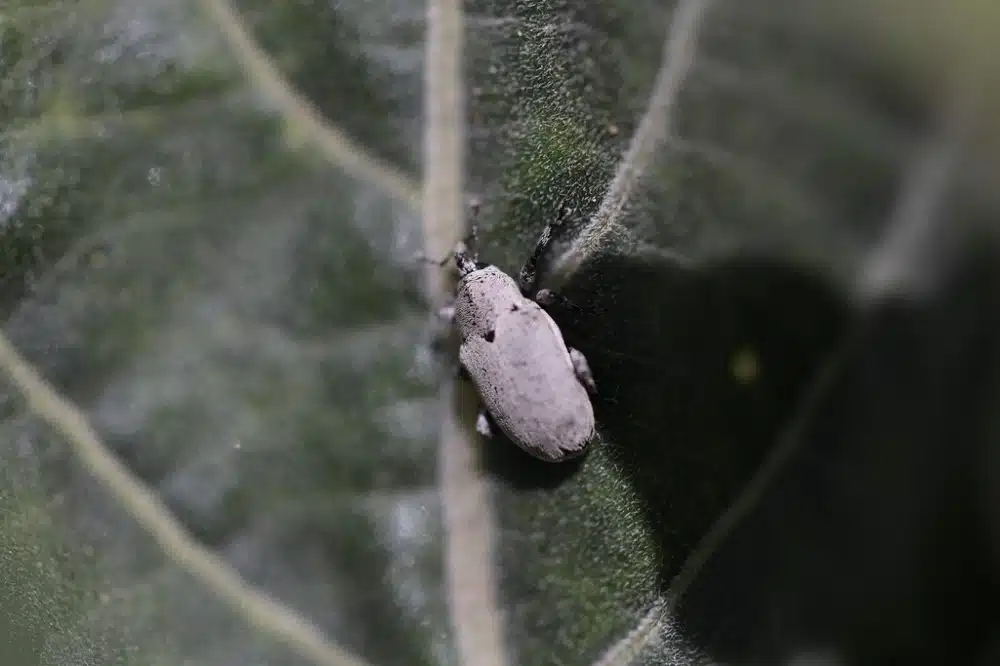
This species is seen in a gray-to-white color and a light green color.
Its off-white color is only contrasted by a few black spots, including one on its head.
The legs of the species are also white.
A North American native, this weevil is sometimes seen in a pale green color.
It can be found on various hosts as it feeds on plant leaves.
16. Zygogramma disrupta
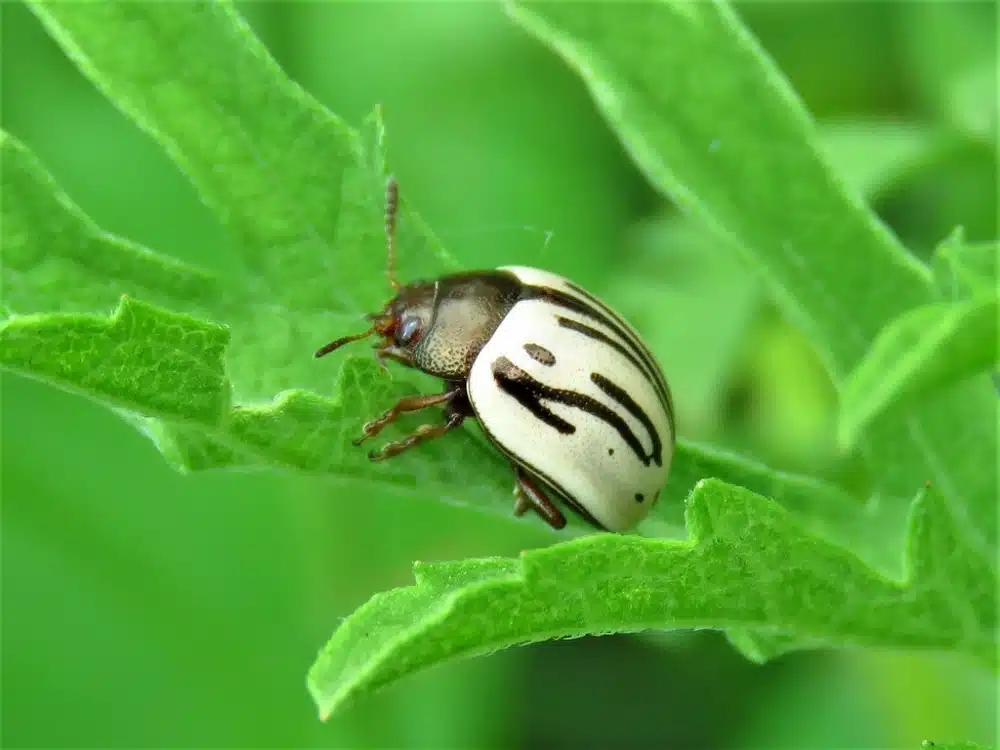
This species is also seen in a few different morphs. A mostly white morph is common.
It comes with vertical contrasting black stripes on white elytra and a black head with short black antennae.
A yellow and black morph is at least as common for the species.
This species has a widespread North American habitat as it feeds on the common ragweed.
It’s an early-season beetle, first seen in April. The beginning of the summer marks the year this species is most likely to be seen.
17. White Oak Borer
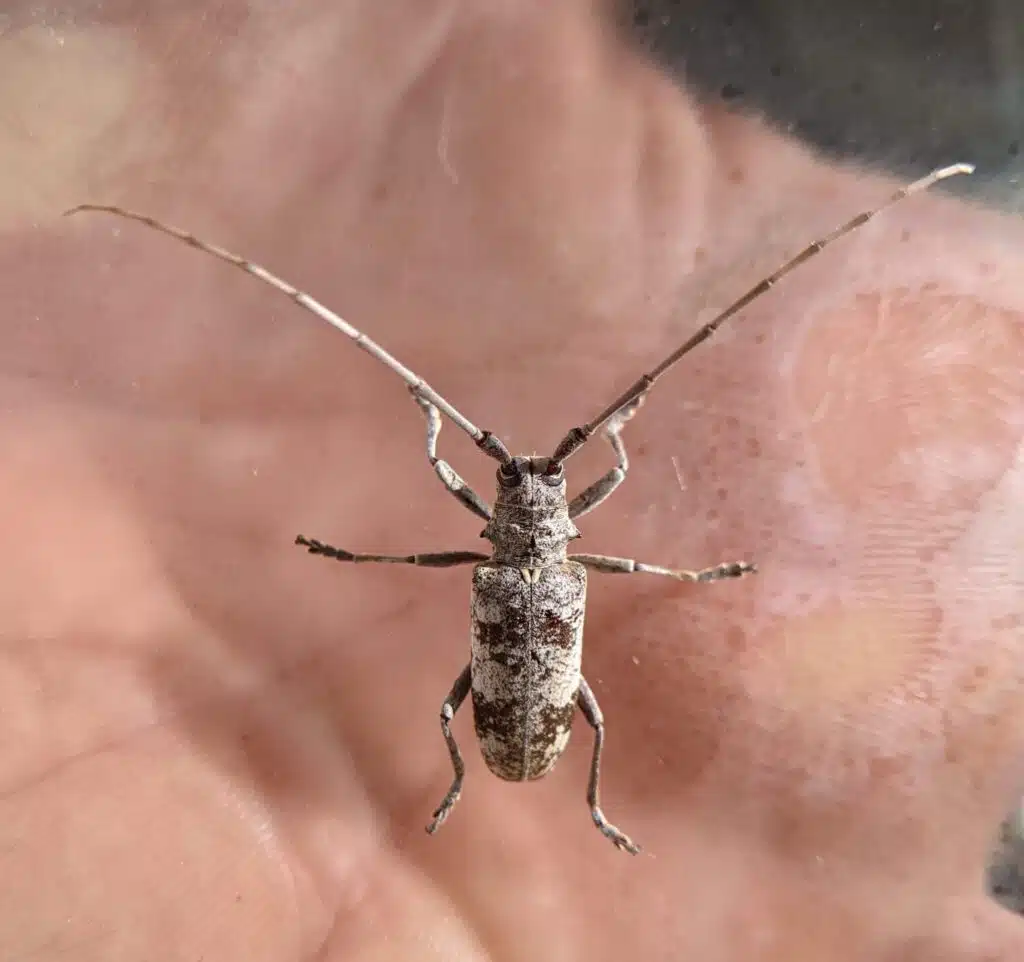
This species (Goes tigrinus) is one of the comprehensive pests of oak trees in North America.
Its long lifespan also makes it a beetle to worry about for those growing decorative white oaks.
The beetle has a mostly white color with brown or gray marks across its body. It mimics oak bark with marks on its body.
Eggs are laid directly in tree bark and emerging larvae start to feed on oak trees as they grow.
Young oak trees are considerably more likely to be affected by this species.
Some of the signs of a possible invasion include sap coming out of the tunnels the larvae live in.
This species lives up to 5 years and it may hinder tree growth or even kill a tree if it populates the host in high numbers.
A low number of natural predators is specific to this large beetle that can grow up to 34mm.